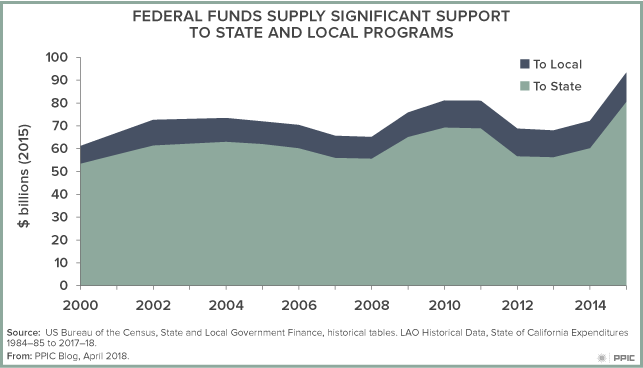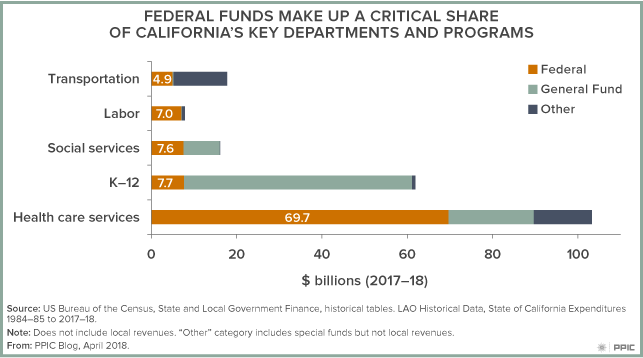California receives a lot of direct funding—more than $100 billion—from the federal government. Should federal officials make changes to the programs that provide these funds, the state would feel the impact quickly, with the most vulnerable Californians bearing the brunt. As lawmakers begin to work on the state budget in earnest, there is less certainty surrounding the contribution of federal funds than in prior years.
Governor Brown’s current budget proposal estimates that federal support will contribute about $106 billion dollars to state and local programs (a large share of the funds “pass through” state departments and are distributed to counties, school districts, and other entities). That would represent a record amount.

In the past, federal revenue to California hovered between $70 and $80 billion. After implementation of the Affordable Care Act (also known as Obamacare), the total level of federal assistance to the state rose beyond the $100 billion mark—mainly because of the expansion of Medi-Cal.
Though it is the largest, Medi-Cal isn’t the only state program that relies on the federal government for a significant share of total revenue. From CalTrans to the California Department of Education, billions of federal dollars provide support for state and local efforts.

Today, relying on that federal revenue could be hazardous. The Trump administration and congressional Republicans have expressed an interest in making significant changes to key programs. For instance, food stamps—known by its federal moniker as Supplemental Nutrition Assistance Program (SNAP) and as CalFresh here in California—may look very different over time. Trump’s proposal limits the ability of recipients to choose which foods they can purchase, claiming that these limitations will save money. These purported savings underpin a proposed 30% overall cut to the program over the next decade.
Should funding for these programs be cut, California—as the nation’s largest state—would bear the greatest dollar reduction. And the state’s poorest would feel the greatest impact. PPIC research has found that the state’s social safety net programs often spell the difference between being in or out of poverty for hundreds of thousands of residents. For example, CalFresh moves 800,000 people out of poverty. The impact of CalWORKs—the state’s welfare program—is smaller, but significant (400,000 moved from poverty). The effect of funding reductions today could be amplified in the next recession, when unemployment rises, incomes fall, and more people seek these benefits.
In the past, California, like other states, could look to the federal government as a reliable source of revenue for many of its programs, especially those making up the social safety net. In fact, the federal government has even served as a partial fiscal buffer during economic downturns, increasing spending when state generated revenues fell. The state, however, cannot take the level of federal support as a given and, for now, will have to navigate in an environment of fiscal uncertainty, particularly with regard to programs that serve the poor. In this budget building season, state leaders will need to consider how best to cope with the possibility of reduced federal assistance in the immediate future.




